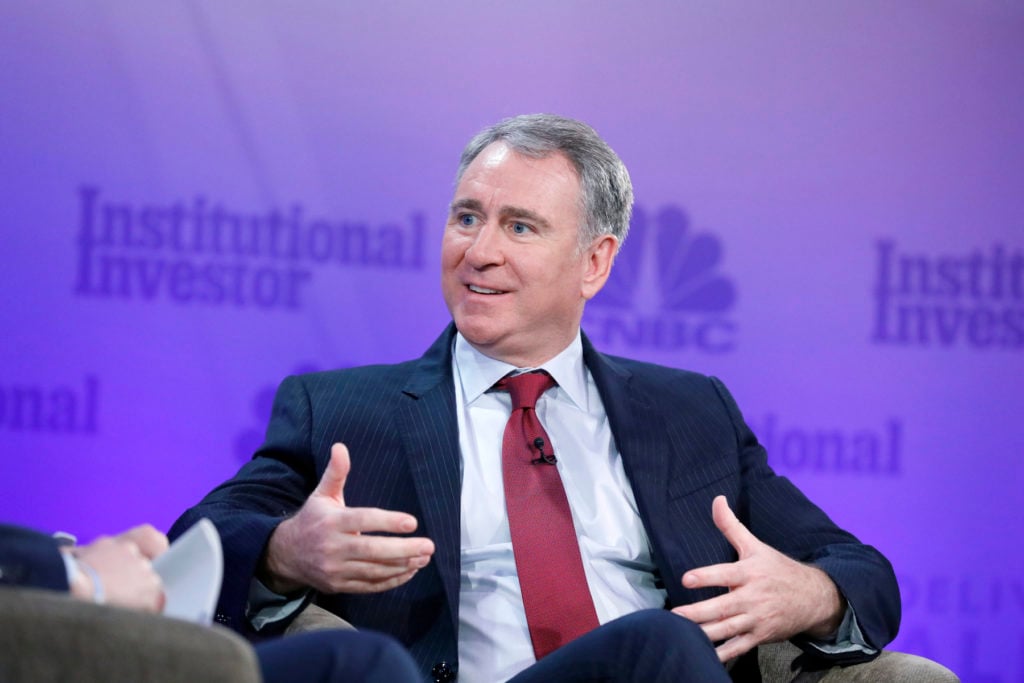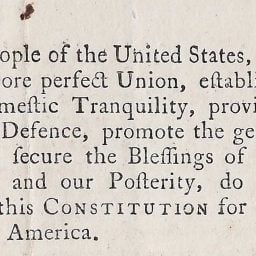In mid-November, hedge-fund billionaire Ken Griffin bought a 1787 copy of the U.S. Constitution at Sotheby’s, and promised to lend it to the Crystal Bridges Museum of American Art in Arkansas.
He beat out ConstitutionDAO, a group of more than 17,000 people who banded together to raise $46 million on the blockchain to purchase the document and put it on public display. Their failed bid, and what it revealed about crypto’s flaws as a tool for rapid crowdfunding, have been covered elsewhere. But Griffin’s victory also sheds considerable light on contemporary auction dynamics in general.
Here’s what it shows us.
The value to an individual of a collectible.
Griffin has acquired a valuable object, which has a lot of utility to him. He has now been identified as an American patriot willing to put many millions of dollars into buying and preserving a copy of the Constitution. He can borrow money against that copy on a non-recourse basis; he can donate it to a non-profit and take a tax deduction for doing so; he can lend it to a museum and thereby curry favor with its billionaire founders.
Plus, of course, he might in theory be able to sell it at a future date for a significant profit. Little if any of that utility was available to the underbidder, which helps explain why Griffin was able to outbid a consortium of more than 17,000 individuals.

Kenneth C. Griffin, Citadel Founder and Chief Executive Officer, at the CNBC Institutional Investor Delivering Alpha conference in NYC. Photo: Heidi Gutman/CNBC/NBCU Photo Bank.
The incredible wealth of billionaires.
On some level, this was never a fair fight. One side had a war chest of over $45 million, and was willing to spend every penny. The other side was an individual so rich that dropping $45 million—or even $145 million—on a single object would make no discernible difference to his lifestyle or his wealth. It’s easy to see why such individuals are coveted clients of the auction houses, and why Sotheby’s might be happy to treat Griffin generously in any given transaction.
The financial value of performative philanthropy.
Griffin’s aim was exactly the same as that of the underbidder: to buy the Constitution and then lend it to a museum. There might have been a difference in exactly which museum was going to receive the donation, but that hardly explains the ferocity of the bidding war between the two sides. Griffin paid well over $40 million not to ensure the Constitution would find its way into a museum—that was a given whether he won or lost—but to be the person who got to lend it to a museum.

Close aerial of Crystal Bridges looking north. Courtesy of Safdie Architects.
A simple tactic to get an upper hand at auction.
Griffin not only knew exactly who he was bidding against; he also knew exactly what their maximum bid was, because they published that number on their website. That made it easy for him to work out exactly how much to offer so that they couldn’t muster a larger bid. In general, advertising your maximum price to rival bidders is a suboptimal bidding strategy.
The mechanics of third-party guarantees.
Long before the Nic Cage and Mean Girls memes took off, Sotheby’s had to secure the lot for itself, rather than see the business lost to archrival Christie’s. In order to do that, Sotheby’s guaranteed the seller, the Dorothy Tapper Goldman Foundation, that it would receive a certain minimum sum from the sale.
That guarantee created a serious financial risk for Sotheby’s. If no bidder materialized at or above the reserve price on the lot, then Sotheby’s would find itself in possession of a 234-year-old piece of paper that it never particularly wanted to own, and that would very publicly have failed to sell at auction. That object would be hard to sell, and meanwhile Sotheby’s would be out somewhere in the region of $15 million.
Sotheby’s therefore found a “third-party guarantor” in the person of Ken Griffin. Griffin committed to bidding at least a certain amount for the copy of the Constitution, in return for a share of the upside if the document ended up selling for far more than the guaranteed amount. Importantly, Griffin was entitled to his share of the upside whether or not he ended up winning the auction.

Sotheby’s chairman Brooke Lampley on the phone for the winning bid of the Constitution at Sotheby’s New York.
The importance of an underbidder.
Artnet News’s own Katya Kazakina reported that Sotheby’s received the guarantee from Griffin after the DAO had amassed a significant war chest. On its face, that doesn’t make a lot of sense. If the DAO was a guaranteed bidder, Sotheby’s could be sure of selling to them, and didn’t need to worry about getting stuck with the object.
The problem was: If the DAO came in very visibly and credibly promising to outbid anybody with less than $40 million to spend for an item that was only estimated at $15 million to $20 million, then there was a real risk no one else would bother to bid at all.
In theory, anybody could just come in and bid $39 million for the lulz, safe in the knowledge that the DAO would outbid them. But in practice, given the layers of vetting you need to go through in order to be able to bid at that level, Sotheby’s couldn’t count on such a thing. In order to guarantee some kind of a bidding war, they were willing to give significant upside to Griffin—a man who could credibly want to buy the Constitution for at or near the amount the DAO was willing to pay, and who therefore couldn’t be easily accused of working in cahoots with the seller or the auction house to merely drive the price up.
The messiness of price reporting.
Griffin’s winning bid was $41 million. According to the standard contract he would have signed as a bidder at Sotheby’s, the total amount he owed was the hammer price of $41 million plus the “buyer’s premium”— 25 percent of the first $400,000, 20 percent of the rest up to $4 million, and 13.9 percent of anything above $4 million. Oh, plus an “overhead premium” of another 1 percent of the hammer price. That combined premium of $6.4 million brought the total amount he bid for the document to $47.4 million.
On the other hand, under the terms of the separate contract Griffin had with Sotheby’s as the guarantor of the work in question, he was owed about 65 percent of the buyer’s premium payable to the auction house, or some $4.2 million.
Historically, some auction houses, including Christie’s, would have reported the price paid by Griffin as $47.4 million; any side dealings involving irrevocable bids and third-party guarantees were considered a separate, confidential matter. Today, however, both Sotheby’s and Christie’s subtract the amount payable to the guarantor from the gross price paid by the winning bidder when the guarantor wins the work. (In other words, when the final price reported by the auction house is lower than the hammer price plus the typical fee structure, they are tipping their hand: the guarantor won.) In this case, Sotheby’s reported the final price paid for the Constitution not as $47.4 million, but rather as $43.2 million.

The First Printing of the Final Text of the United States Constitution is on display during a press preview at Sotheby’s on September 17, 2021 in New York City. (Photo by Alexi Rosenfeld/Getty Images)
The trustworthiness of auction prices (or lack thereof).
In an art world that’s notorious for opacity and mendacity, published auction prices are the closest thing there is to a gold standard—an unfudgeable and indelible record of how much someone really paid for a certain work at a certain time. And yet, once third-party guarantees get involved, headlines soon follow using words like “murky” and “mysterious.”
It’s easy to see why. When the DAO bid $40 million, they were committing to pay a total amount of $46.2 million. And yet they got outbid by someone paying $3 million less than that amount.
For anybody using auction prices as a guide to the maximum amount that a bidder was willing to pay in a certain salesroom on a certain day, the $43.2 million figure is decidedly misleading. After all, the DAO bid more than that themselves when they offered a hammer price of $40 million.
And while $43.2 million is definitely the final net cost to Griffin, in another sense it doesn’t represent the true net cost he was willing to pay.
Think about it this way: If Griffin had stopped bidding after the DAO’s $40 million bid, the DAO would have won the auction, the final recorded price would have been $46.2 million, and Sotheby’s would have written Griffin a check for somewhere in the region of $4 million. The second after the DAO made that bid, Griffin was $4 million in the black. By putting in an extra bid at the $41 million level, he swung all the way to $43.2 million in the red. The cost of that final bid, to Griffin, was the magnitude of the swing —some $47.2 million.
Of course, it’s impossible to convey all that subtlety in a single reported number. Sotheby’s has a simple binary choice: It can record the final price paid as $47.4 million, or it can record the final price paid as $43.2 million. Neither number fully represents the “truth”—because auctions aren’t nearly as clean and simple as many art-world observers would like to believe.













